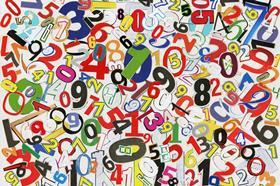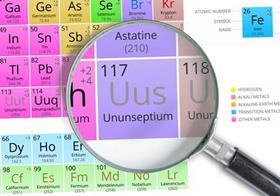Silver mirror test - a safety note, Algebra or calculus?, Periodic terms and Waters of oblivion
Silver mirror test - a safety note
When demonstrating the silver mirror test (see Educ. Chem., 2007, 44 (1), 12) teachers should freshly prepare their Tollens' reagent (alkaline ammoniacal silver nitrate) and never store the solution for more than a couple of hours because of the risk of explosion. These precautions are to prevent the formation of silver nitride (Ag3N) and silver fulminate (AgONC) - silver(i) oxidoazaniumylidynemethane.
Following the demonstration, any excess Tollens' reagent should be acidified with dilute nitric acid before being washed down the sink with plenty of water. It should not be placed in a silver residues container. The flask containing the silver mirror should be thoroughly rinsed with water as soon as the demonstration is finished and the washings flushed down the sink.
Colin Baker,Bedford
Algebra or calculus?

In the first of the new series Maths for chemists (Educ. Chem., 2007, 44 (1), 27) Paul Yates quotes the IUPAC Compendium of Chemical Terminology definition of quantity calculus as 'algebra with quantities where the symbols of quantities represent products of numerical values and their units'. It is a simple, logical and powerful method of handling physical quantities, both their numerical values and their units but the principles involved as clearly stated in the IUPAC definition are based on algebra and not on what we normally understand to be calculus.
Although it is the method that is important, the somewhat awesome name can have the unfortunate consequence that it causes students, particularly those of limited mathematical ability, to close their minds to what follows. I have found over a number of years that teaching the manipulation of physical quantities in this way is much more productive if introduced as quantity algebra. The name quantity calculus can be introduced subsequently when students are conversant with the method, though I would support a permanent change in name.
Readers may also be interested in two other strategies arising from the article that I have found useful in reducing the number of errors made when students do calculations using equations relating physical quantities. First, calculations should be done on equations written in the form eg
pV = nRT
rather than p= nRT/V, since students find it easier to cancel units, exponents of 10 etc. Second, if it is necessary to carry out any unit conversions then this is better done in the final expression involving all the units and numerical values, rather than in the individual physical quantities before being substituted into an equation. This leads to fewer errors in transposition as has occurred for the molar mass Min the worked example given.
It should be emphasised that the use of quantity algebra does not necessitate the use of SI units. It is applicable to the use of any units. Other teaching strategies found to be helpful in the use of quantity algebra have been described elsewhere (see U. Chem. Educ., 2003, 7, 58).
Jack Hoppé
Periodic terms
We have recently received a copy of the Periodic Table, published by AstraZeneca and distributed via the Royal Society of Chemistry's Schools and Colleges Publications Service, that avoids the term 'metalloids' and uses, instead, the term 'poor metals', all of which appear to be elements capable of forming amphoteric oxides. Is this now the correct designation of these elements? If so, it would require a change in many textbooks, and in our teaching.
John G. Gellner, Ateneo de Davao University, Philippines
In response
Gordon Woods, Periodic Table enthusiast, Oakham, Rutland, says:

Humans like to classify things. Elements are divided into metals and non-metals. The problem is that some elements behave in some ways like metals and in other ways like non-metals. (That is why I don't draw the Periodic Table with a staircase between elements but with a diagonal line passing through these elements.) Personally I prefer the term metalloid for these special elements but am happy with semi-metal (but why not semi-non-metal?). You mentioned that these elements have amphoteric oxides, ie oxides with chemical properties of both metal oxides and non-metal oxides. Note that for most metalloids the non-metal nature is more apparent in chemical properties and the metallic nature in the physical properties. Thus aluminium looks like a metal, it is a good conductor but its anhydrous chloride is covalent. 'Poor metals' is a poor term.
Waters of oblivion
Peter Childs, in his Chemlingo on waters of oblivion (Educ. Chem., 2007, 44 (1), 8), states 'Before the introduction of ether and later chloroform doctors used laudanum and alcohol to make patients insensible to pain'. He might have added to his list hypnosis, nerve compression, blows to the head, freezing, dubious electrical connections and application of the 'soporific sponge'.*
In truth, none was particularly effective and some were distinctly risky. In particular, taken orally, the amount of alcohol or laudanum (a morphine-containing alcoholic extract of opium) needed to achieve insensibility to pain was uncomfortably close to the lethal dose and patients were liable to die from poisoning, rather than the effects of the operation. Most pre-1846 textbooks on surgery pay no attention to minimising operative pain. Mainly, only swiftness in procedure was the universal means of limiting patients' distress - some surgeons could amputate a leg in less than 30 seconds.
As a post-script, however, an extract of opium was used in the form of an intravenous injection to render a dog temporarily unconscious. The worker was Christopher Wren, later to find enduring fame as the architect of St Paul's Cathedral, and the year was 1659. Sadly, though, he did not see the potential of his experiment as a means of alleviating operative pain, and pain and surgery were to go hand in hand until the mid-1840s.
Alan Dronsfield, Derby
* This was a sponge soaked in the juices of opium, hemlock, henbane, lettuce and other plants and then air-dried. It was 'revived' by soaking in water and held under the patient's nose, supposedly inducing unconsciousness.



No comments yet